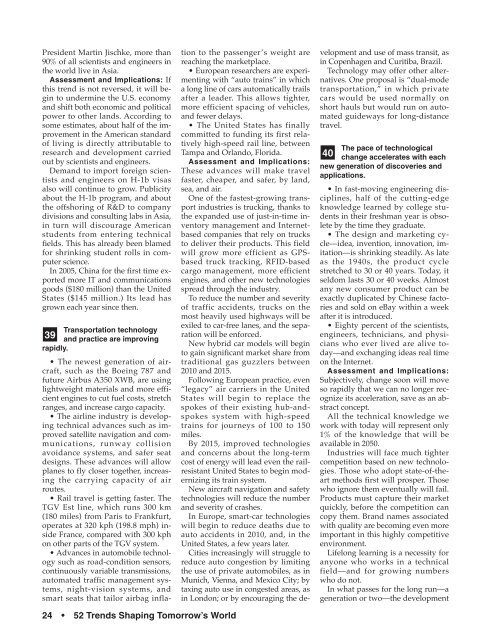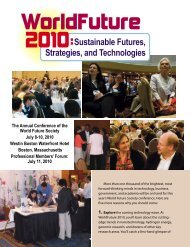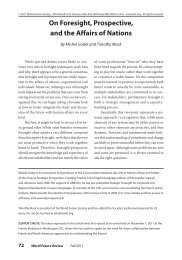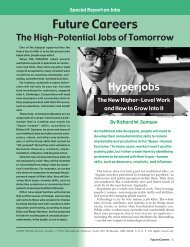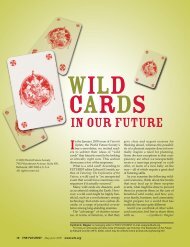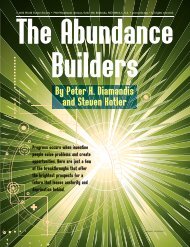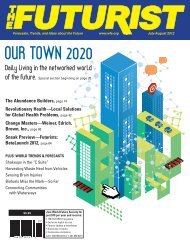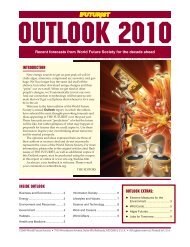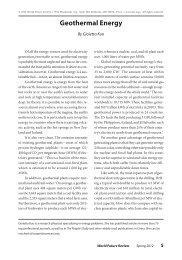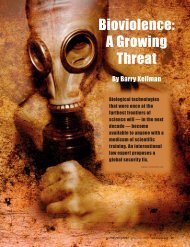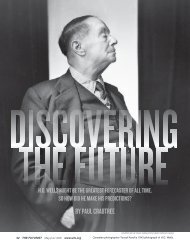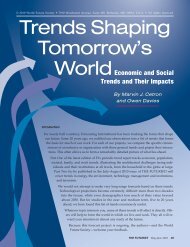52 Trends Shaping Tomorrow's World - World Future Society
52 Trends Shaping Tomorrow's World - World Future Society
52 Trends Shaping Tomorrow's World - World Future Society
You also want an ePaper? Increase the reach of your titles
YUMPU automatically turns print PDFs into web optimized ePapers that Google loves.
President Martin Jischke, more than90% of all scientists and engineers inthe world live in Asia.Assessment and Implications: Ifthis trend is not reversed, it will beginto undermine the U.S. economyand shift both economic and politicalpower to other lands. According tosome estimates, about half of the improvementin the American standardof living is directly attributable toresearch and development carriedout by scientists and engineers.Demand to import foreign scientistsand engineers on H-1b visasalso will continue to grow. Publicityabout the H-1b program, and aboutthe offshoring of R&D to companydivisions and consulting labs in Asia,in turn will discourage Americanstudents from entering technicalfields. This has already been blamedfor shrinking student rolls in computerscience.In 2005, China for the first time exportedmore IT and communicationsgoods ($180 million) than the UnitedStates ($145 million.) Its lead hasgrown each year since then.n 39rapidly.Transportation technologyand practice are improving• The newest generation of aircraft,such as the Boeing 787 andfuture Airbus A350 XWB, are usinglightweight materials and more efficientengines to cut fuel costs, stretchranges, and increase cargo capacity.• The airline industry is developingtechnical advances such as improvedsatellite navigation and communications,runway collisionavoidance systems, and safer seatdesigns. These advances will allowplanes to fly closer together, increasingthe carrying capacity of airroutes.• Rail travel is getting faster. TheTGV Est line, which runs 300 km(180 miles) from Paris to Frankfurt,operates at 320 kph (198.8 mph) insideFrance, compared with 300 kphon other parts of the TGV system.• Advances in automobile technologysuch as road-condition sensors,continuously variable transmissions,automated traffic management systems,night-vision systems, andsmart seats that tailor airbag infla-tion to the passenger’s weight arereaching the marketplace.• European researchers are experimentingwith “auto trains” in whicha long line of cars automatically trailsafter a leader. This allows tighter,more efficient spacing of vehicles,and fewer delays.• The United States has finallycommitted to funding its first relativelyhigh-speed rail line, betweenTampa and Orlando, Florida.Assessment and Implications:These advances will make travelfaster, cheaper, and safer, by land,sea, and air.One of the fastest-growing transportindustries is trucking, thanks tothe expanded use of just-in-time inventorymanagement and Internetbasedcompanies that rely on trucksto deliver their products. This fieldwill grow more efficient as GPSbasedtruck tracking, RFID-basedcargo management, more efficientengines, and other new technologiesspread through the industry.To reduce the number and severityof traffic accidents, trucks on themost heavily used highways will beexiled to car-free lanes, and the separationwill be enforced.New hybrid car models will beginto gain significant market share fromtraditional gas guzzlers between2010 and 2015.Following European practice, even“legacy” air carriers in the UnitedStates will begin to replace thespokes of their existing hub-andspokessystem with high-speedtrains for journeys of 100 to 150miles.By 2015, improved technologiesand concerns about the long-termcost of energy will lead even the railresistantUnited States to begin modernizingits train system.New aircraft navigation and safetytechnologies will reduce the numberand severity of crashes.In Europe, smart-car technologieswill begin to reduce deaths due toauto accidents in 2010, and, in theUnited States, a few years later.Cities increasingly will struggle toreduce auto congestion by limitingthe use of private automobiles, as inMunich, Vienna, and Mexico City; bytaxing auto use in congested areas, asin London; or by encouraging the de-velopment and use of mass transit, asin Copenhagen and Curitiba, Brazil.Technology may offer other alternatives.One proposal is “dual-modetransportation,” in which privatecars would be used normally onshort hauls but would run on automatedguideways for long-distancetravel.n 40The pace of technologicalchange accelerates with eachnew generation of discoveries andapplications.• In fast-moving engineering disciplines,half of the cutting-edgeknowledge learned by college studentsin their freshman year is obsoleteby the time they graduate.• The design and marketing cycle—idea,invention, innovation, imitation—isshrinking steadily. As lateas the 1940s, the product cyclestretched to 30 or 40 years. Today, itseldom lasts 30 or 40 weeks. Almostany new consumer product can beexactly duplicated by Chinese factoriesand sold on eBay within a weekafter it is introduced.• Eighty percent of the scientists,engineers, technicians, and physicianswho ever lived are alive today—andexchanging ideas real timeon the Internet.Assessment and Implications:Subjectively, change soon will moveso rapidly that we can no longer recognizeits acceleration, save as an abstractconcept.All the technical knowledge wework with today will represent only1% of the knowledge that will beavailable in 2050.Industries will face much tightercompetition based on new technologies.Those who adopt state-of-theartmethods first will prosper. Thosewho ignore them eventually will fail.Products must capture their marketquickly, before the competition cancopy them. Brand names associatedwith quality are becoming even moreimportant in this highly competitiveenvironment.Lifelong learning is a necessity foranyone who works in a technicalfield—and for growing numberswho do not.In what passes for the long run—ageneration or two—the development24 • <strong>52</strong> <strong>Trends</strong> <strong>Shaping</strong> Tomorrow’s <strong>World</strong>


